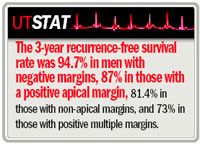Article
Post-radical prostatectomy margin location may affect recurrence risk
Author(s):
A solitary positive apical margin following radical prostatectomy is associated with a higher biochemical recurrence rate than are negative surgical margins., but positive apical margins are associated with a lower recurrence rate than non-apical or multifocal positive margins are.

In addition, the prognostic significance of positive apical margins appears to be more important in stage T2 disease than in stage T3, he said.
Dr. Clark's group evaluated biochemical recurrence in 1,667 patients with stage T2 or T3a prostate cancer after prostatectomy who had a positive surgical margin at final pathology.
"In the overall group, those with an apical margin did worse than those with a negative margin; however, they did better than those with positive margins at other locations," Dr. Clark said.
The 3-year biochemical recurrence-free survival rate was 94.7% among men with negative margins, 87% among those with a positive apical margin, 81.4% among those with non-apical margins, and 73.0% among those with positive multiple margins.
"That story was essentially the same when we looked at only those with T2 disease," Dr. Clark told Urology Times.
"However, when we isolated those with just higher-stage disease, T3a, now there was no difference between those with an apical margin and those with a negative margin."
In a multivariate model, predictors of recurrence were preoperative PSA level, a higher Gleason grade, and a higher T stage, but not a positive apical margin, "whereas margins in other locations were associated with worse outcome," he said. "A positive apical margin probably has more prognostic relevance in those with T2 disease. In the converse, a positive apical margin is probably less clinically important than those in other locations."
Depending on the series, 11% to 38% of radical prostatectomy specimens are margin positive, with the prostatic apex being the most common site for positive margins.
The finding that solitary apical margins appear to have less impact on biochemical recurrence is consistent with the anatomic complexity and difficulty in diagnosing positive margins in this area, and suggests that some apical positive surgical margins may not be clinically relevant.





